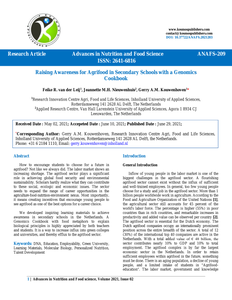How to encourage students to choose for a future in agrifood? Not like we always did. The labor market shows an increasing shortage. The agrifood sector plays a significant role in achieving global food security and environmental sustainability. Scholars hardly realize what they can contribute to these social, ecologic and economic issues. The sector needs to expand the range of career opportunities in the agriculture-food-nutrition-environment nexus. Most importantly, it means creating incentives that encourage young people to see agrifood as one of the best options for a career choice. We developed inspiring learning materials to achieve awareness in secondary schools in the Netherlands. A Genomics Cookbook with food metaphors to explain biological principles is highly appreciated by both teachers and students. It is a way to increase influx into green colleges and universities, and thereby efflux to the agrifood sector.
MULTIFILE

The agrifood sector is crucial for achieving global food security and environmental sustainability. In the Netherlands, innovations in food technology and adjacent areas are achieved in attractive projects at Universities of Applied Sciences (UASs) in close interaction with government, industry, other knowledge institutes and society. By providing students central positions in innovative joint efforts that answer to the demands of small and medium sized enterprises, the curricula stay up to date and appealing. Examples of such efforts are the Food Innovation Academy (FIA), the World Horti Centre (WHC) and the Food Innovation Community Amsterdam (FICA). Interdisciplinary projects in these settings help to encourage students to choose for a future in agrifood. Exposure is key to reach the target groups. For that reason, several paths on the roadmap of the human capital agenda have to be taken. We developed inspiring learning materials that appeal to students and teachers in secondary schools. A “Genomics Cookbook” to introduce biological knowledge behind nutrigenomics and a velcro-model called “DNAbAND” to explain principles behind the Polymerase Chain Reaction for food safety applications, are examples. These are ways to increase influx into green colleges and universities, and thereby efflux to the agrifood sector.
DOCUMENT

In this chapter, we discuss the education of secondary school mathematics teachers in the Netherlands. There are different routes for qualifying as a secondary school mathematics teacher. These routes target different student teacher populations, ranging from those who have just graduated from high school to those who have already pursued a career outside education or working teachers who want to qualify for teaching in higher grades. After discussing the complex structure this leads to, we focus on the aspects that these different routes have in common. We point out typical characteristics of Dutch school mathematics and discuss the aims and challenges in teacher education that result from this. We give examples of different approaches used in Dutch teacher education, which we link to a particular model for designing vocational and professional learning environments.We end the chapter with a reflection on the current situation.
LINK
CRYPTOPOLIS is a project supported by EU which focuses on the financial management knowledge of teachers and the emerging field of risk management and risk analysis of cryptocurrencies. Cryptocurrency has shown to be a vital and rapidly growing component in today’s digital economy therefore there is a need to include not just financial but also crypto literacy into the schools. Beside multiple investors and traders the market is attracting an increasing number of young individuals, viewing it as an easy way to make money. A large pool of teenagers and young adults want to hop on this train, but a lack of cryptocurrency literacy, as well as financial literacy in general amongst youth, together with their inexperience with investing makes them even more vulnerable to an already high-risk investment.Therefore, we aim to increase the capacity and readiness of secondary schools and higher educational institutions to manage an effective shift towards digital education in the field of crypto and financial literacy. The project will develop the purposeful use of digital technologies in financial and crypto education for teaching, learning, assessment and engagement.
This project aims to empower learners to take ownership of their own education. We aim to implement and evaluate a digital learning dashboard that scaffolds learner autonomy by providing insights in learning goals, learning strategies, and plans as well as offering guided reflection and adaptation. The learning dashboard as developed by Talent Tree will be implemented and evaluated in close cooperation with a number of schools in secondary education. We seek to learn from the implementation and use of the dashboard and develop guidelines and for future use and design improvements.